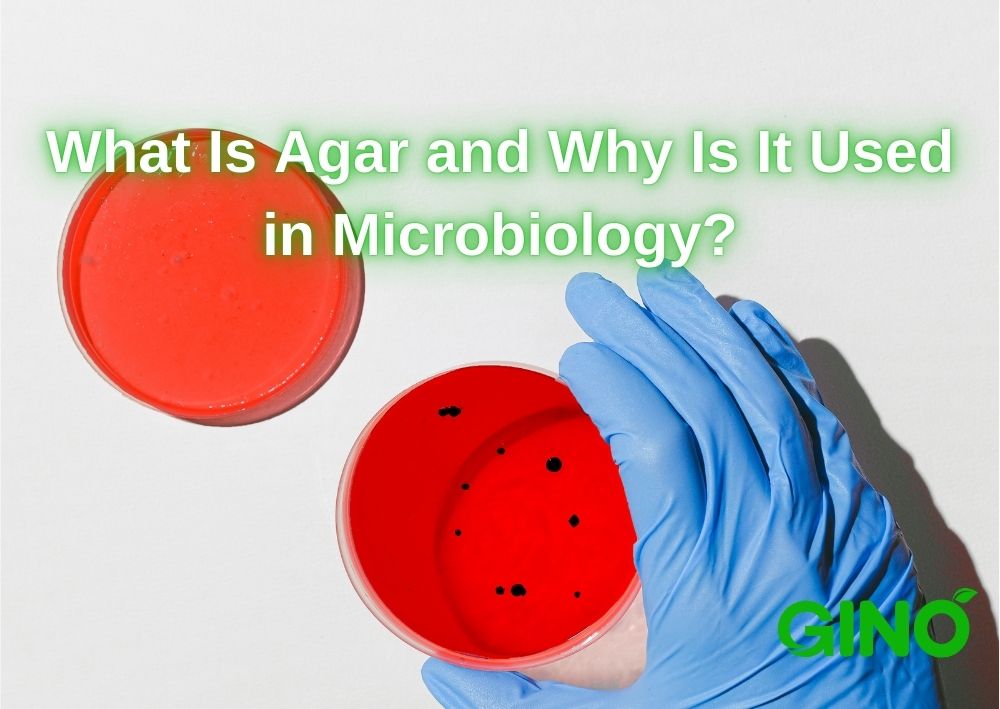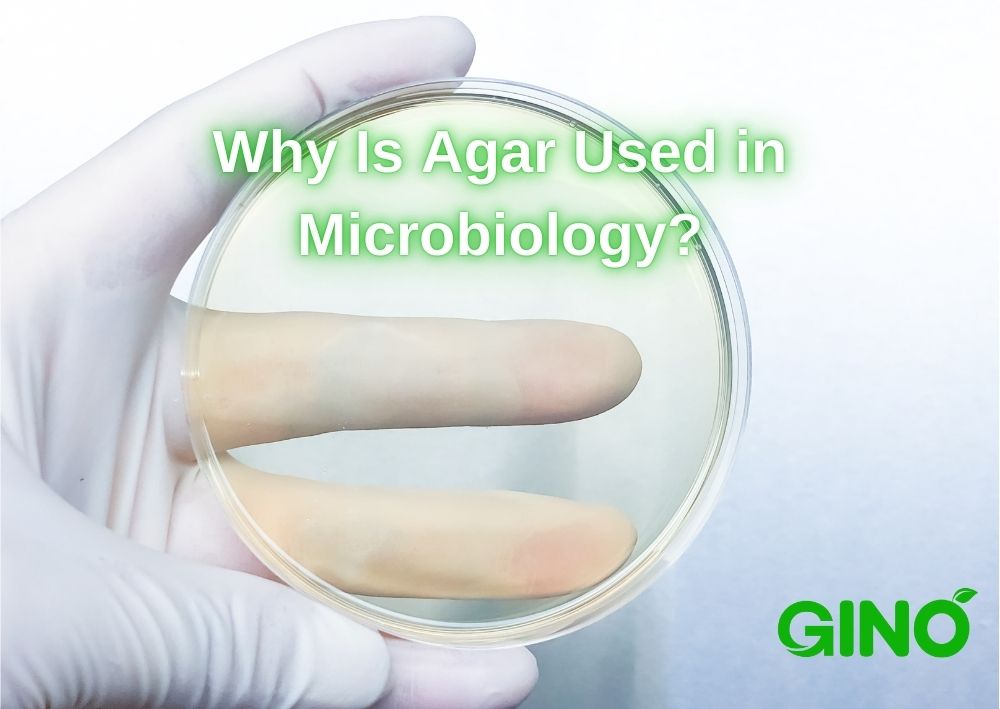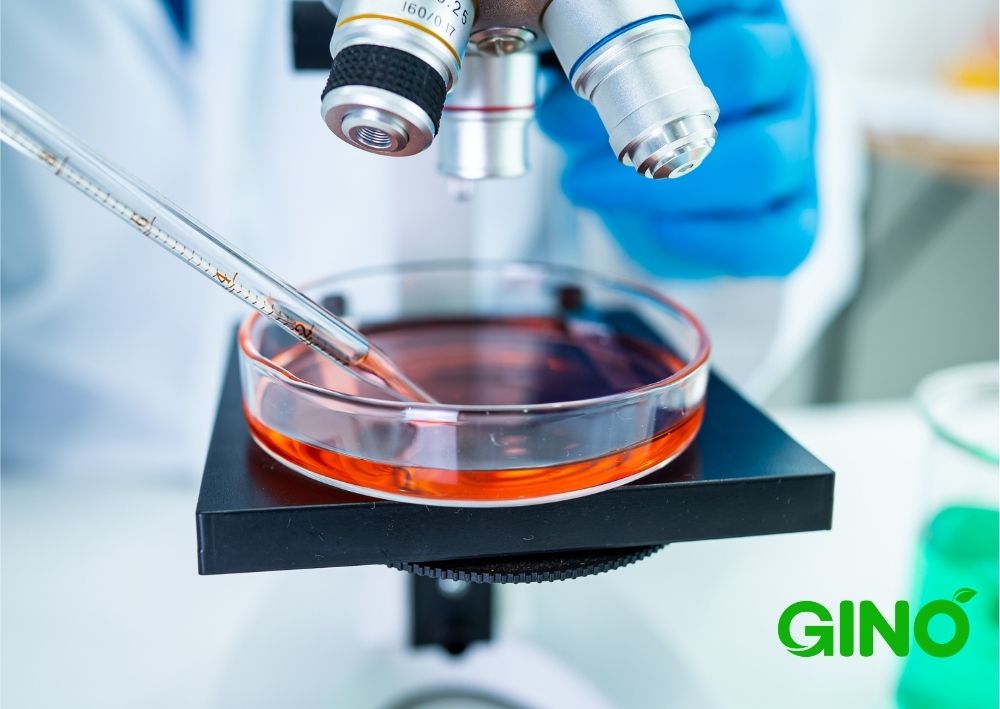Desde hace más de 10 años, Gino Biotech es uno de los principales proveedores de hidrocoloides alimentarios. Con nuestra variedad de gomas y estabilizantes de origen vegetal, podemos crear soluciones de hidrocoloides a medida perfectamente adaptadas a las necesidades de nuestros clientes. LEER MÁS
¿Qué es el agar y por qué se utiliza en microbiología?
¿Qué es el agar y por qué se utiliza en microbiología?
Facebook
Twitter
LinkedIn
El agar puede parecer un aditivo alimentario más, pero en el mundo de la microbiología es un héroe anónimo.
Si alguna vez te has preguntado qué es el agar y por qué se utiliza en microbiologíaestá a punto de descubrir su papel fundamental en la investigación científica. El agar es indispensable en los laboratorios de todo el mundo, ya sea para ayudar a los científicos a cultivar bacterias o para avanzar en los descubrimientos médicos.
Este artículo le explicará qué es exactamente el agar y por qué es una piedra angular de los estudios microbiológicos.

¿Qué es el agar?
El agar es una sustancia gelatinosa derivada de algas rojas, principalmente de especies como el Gelidium y Gracilaria. Se utiliza habitualmente como hidrocoloide en la industria alimentaria, pero su papel en microbiología es lo que realmente lo hace especial.
El agar tiene la capacidad de gelificarse cuando se mezcla con agua, creando un medio sólido que favorece el crecimiento de microorganismos como bacterias, hongos y levaduras. El compuesto es de origen natural y contiene polisacáridos, principalmente agarosa y agaropectina, que le confieren sus propiedades únicas.
¿Por qué se utiliza el agar en microbiología?

El agar es el principal agente solidificante de los medios de cultivo microbiológicos. He aquí por qué es tan valioso:
Sustancia no nutritiva:
El agar en sí no interfiere en el crecimiento de los microbios porque no es nutritivo. Esto lo convierte en una base ideal para añadir nutrientes específicos para el microorganismo que está estudiando, sin contribuir al crecimiento microbiano.
Estabilidad térmica:
Una de las mejores propiedades del agar es su capacidad para mantenerse sólido a temperaturas relativamente altas. El agar se funde a unos 85 °C, pero permanece sólido incluso hasta los 40 °C, lo que lo hace ideal para su uso en una amplia gama de condiciones de temperatura. Esto es especialmente útil en los laboratorios de microbiología, donde se necesitan varias temperaturas para cultivar distintos tipos de microorganismos.
Visibilidad clara:
El agar crea un medio transparente que permite a los científicos observar fácilmente las colonias que se forman en su superficie. Esta estructura clara es vital para identificar y diferenciar los distintos microorganismos.
Textura firme pero flexible:
Cuando se solidifica, el agar crea una superficie firme pero ligeramente elástica. Esto es importante para manipular y transferir cultivos microbianos sin que el medio se rompa o se seque demasiado rápido.
Compatibilidad de esterilización:
El agar puede soportar altas temperaturas durante el autoclave, un proceso que esteriliza los medios de cultivo. Esto garantiza que el medio permanezca estéril antes de la inoculación, evitando la contaminación en los experimentos.
Aplicaciones del agar en microbiología
Ahora que hemos cubierto qué es el agar y por qué se utiliza en microbiologíaexploremos algunas de sus aplicaciones más comunes en el laboratorio:
Cultivos bacterianos:
El agar se utiliza en placas de Petri como medio de crecimiento para las bacterias. El agar nutriente, el agar sangre y el agar MacConkey son sólo algunos ejemplos de medios especializados basados en agar que ayudan a los investigadores a cultivar y estudiar diversas especies bacterianas.
Estudios sobre hongos:
Además de para bacterias, el agar también se utiliza mucho para cultivar hongos. El agar Sabouraud es un medio popular para cultivar organismos fúngicos como la levadura y el moho.
Pruebas de antibióticos:
El agar es esencial en las pruebas de susceptibilidad a los antibióticos. El método de difusión en disco, o prueba de Kirby-Bauer, utiliza placas de agar para determinar la eficacia con la que los antibióticos inhiben el crecimiento bacteriano. Las zonas claras que se forman alrededor de los discos de antibiótico en el agar permiten a los investigadores medir la potencia del antibiótico.
Biología molecular:
La agarosa, un componente del agar, es crucial en la electroforesis en gel, una técnica utilizada para separar fragmentos de ADN. Este método ayuda a los científicos a analizar el material genético visualizando el ADN bajo luz ultravioleta.
Investigación alimentaria y farmacéutica:
El agar no es sólo una herramienta para los microbiólogos; también se utiliza en la seguridad alimentaria y la investigación farmacéutica. Por ejemplo, a menudo se utiliza para comprobar la pureza de los ingredientes o verificar la ausencia de contaminantes en diversos productos.

Conclusión
Como puede ver, el agar desempeña un papel fundamental en microbiología, ya que proporciona a los científicos un medio fiable, estable y estéril para cultivar y estudiar microorganismos.
Tanto si trabaja en un laboratorio como si simplemente siente curiosidad por sus usos, entender qué es el agar y por qué se utiliza en microbiología abre la puerta a una apreciación más profunda del progreso científico.
Desde el descubrimiento de antibióticos que salvan vidas hasta la identificación de patógenos nocivos, el agar ha cambiado realmente la forma en que exploramos el mundo microbiano.

En Gino Biotech somos especialistas en productos de agar de alta calidad perfectos para aplicaciones microbiológicas y alimentarias.
Tanto si está llevando a cabo una investigación pionera como si está desarrollando la próxima gran innovación alimentaria, nuestro equipo está aquí para atender sus necesidades.
Póngase en contacto con nosotros hoy mismo para obtener más información sobre nuestra oferta de agar y otros hidrocoloides.
Contacte con nuestro equipoEntradas recientes
Acerca de Gino Biotech

Somos una empresa biotecnológica especializada en la investigación, desarrollo y comercialización de aditivos alimentarios innovadores y tecnológicos hidrocoloides Agar Agar, Carragenina, y Soluciones de estabilizadores a medida.
Gracias a nuestros amplios conocimientos y experiencia en la investigación, aplicación y uso de hidrocoloides, podemos ofrecer un servicio integral de soluciones personalizadas perfectamente adaptados a las necesidades de nuestros clientes.
Nuestra productos cubren las necesidades de los sectores cárnico, lácteo, panadero, pastelero y otros sectores industriales.
Póngase en contacto con nuestro representante de ventas para obtener más información.














